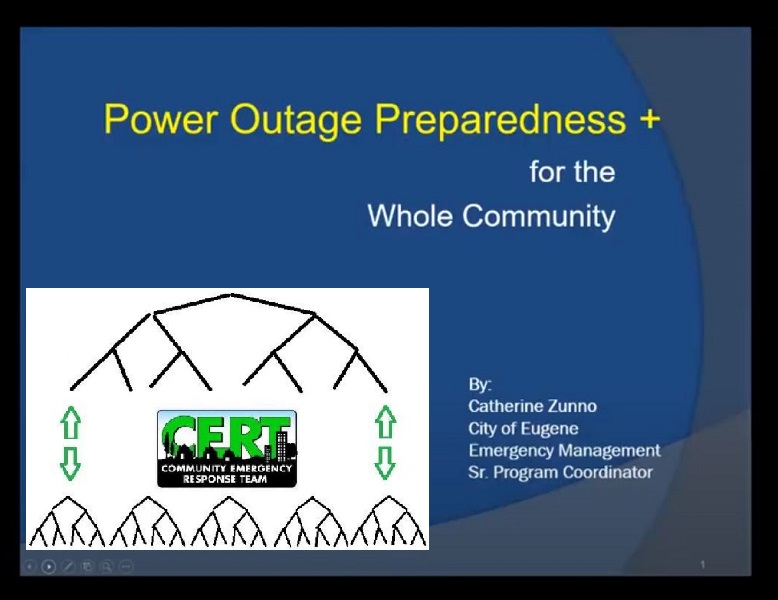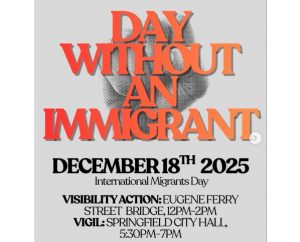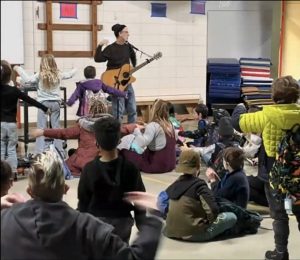Neighbors prepare for flooding, winter travel, power outages
8 min read
Ready NW invited the City's Catherine Zunno to share information about flooding, winter travel, and power outages.
Winter brings flooding, dangerous travel conditions and power outages. River Road Emergency Preparedness co-chair Jacque Wurster.
[00:00:07] Jacque Wurster: About the flooding lately with the weather that we’ve been having, something to keep an eye on is not just your proximity to the river, but potentially any storm drains that might be backing up. We had experienced that a lot in the last couple of days. The drains were clear on the street, but the water was just kind of backing up and piling up and getting dangerously close to the neighbors’ houses. So just a plug to keep an eye on those rapidly changing conditions as we’re in this current rainy season.
[00:00:32] John Q: From the City of Eugene, Catherine Zunno.
[00:00:35] Catherine Zunno: Yeah, that’s a good reminder. Thank you, Jackie. Because sometimes actually, if your storm drain is one of those that is labeled as going directly into the Willamette and usually you’ll see that little fish, the salmon sign on it because it has a direct connection, and when the rivers get really backed up, it can actually surcharge back up that pipeline. So it’s not uncommon to have those start bubbling back up onto the street. We would want you to always be very careful in approaching a storm drain. In fact, don’t approach a storm drain because the cover may have lifted. If you see that situation or if you’re aware of that situation of something that’s back flowing, or that is just really flooding do call into Public Works and let them know.
Thank you for supporting
local citizen journalism
[00:01:17] John Q: New inundation maps will show where flooding will occur during failure of a dam upstream.
[00:01:21] Catherine Zunno: You will have access to see those new maps that have been updated by U.S. Army Corps of Engineers. When you see those popping up, you will probably be very surprised about how much of a water swell in many areas that there is anticipated to be from some of those things. So even more of a urgency to be prepared and to actually pay attention to changing conditions.
[00:01:45] John Q: Catherine Zunno encouraged everyone to prepare for winter travel.
[00:01:49] Catherine Zunno: You don’t want to be trapped, like we’ve seen on I-84, where people have been waiting five and seven hours and they have to keep their car running to keep the heat going.
[00:01:57] You have to preplan and prepare. Things like being sure that your gas tanks in your vehicles are full, not halfway but full. And when the power goes down for you, the gas station power goes out as well. So that’s why it’s important. If you see us a storm system or a bad weather event coming, don’t be thrifty about it. Get to the gas station, get your tank full up. If you have a generator, get extra gas for your generator. If you’re traveling, be extra sure of the weather if it appears to be worsening, either fill up your tank often as you’re traveling along, most of us travel, we’ll go to the end of the tank. We’ll pull into the station and fill up. So for traveling, make sure that you’re watching that weather and that you’re keeping prepared.
[00:02:36] You’ll need to keep food and water in your car. And also it’s good to bring an emergency blankets. Those little tiny blankets, that fold-up, less than a packages of Kleenex, keep a couple three of those in your car at all times. You can use it as an emergency blanket to maintain your heat in your body. If you’ve got kids in the car in the backseat, they might not be getting as much heat coming out of the heater system, wrap one around them in the back seat. The other thing that you can do is if it’s a really hot day and you’re stuck there and you’re not moving, tuck one up in the front of your windshield underneath the visors, it’ll keep the sun out of the car. So it’s just kind of a nice, easy thing to do.
[00:03:11] You want to also keep your water and any medications or baby formulas easy and accessible because you don’t want to step outside of your car in the snow or in the heat and lose all that heat or air conditioning from your car. Or worse yet, get hit by another vehicle who’s being anxious and trying to get by everybody. So keep that stuff within an easy reach of your car.
[00:03:31] John Q: Catherine said each family should create a plan and take time to practice.
[00:03:36] Catherine Zunno: You always want to be at least at the minimum two weeks ready. We actually are trying to tell people to be at least three weeks ready, and that is per person. So when you’re getting together your kits of water and food and so forth, make sure that you have enough to last for at least the minimum of two weeks, preferably three.
[00:03:53] Create your own family plan and practice it. We also try to tell people that it’s kind of a fun event. Hey, in the summertime, go out practice, you know, and you can just call up your kids and say, Hey, we’re having our fake earthquake, you need to make it back to the house. When they make it back to the house, you’re going to pull out all your equipment, you’re going to camp in the backyard. You’re going to try all those yummy freeze- dried foods. And you’re going to pretend literally I have had people that literally have shut off their subpanel, and really practice not having anything, no communications, no phones, everything gets put up and you work through it. So do try to practice if you have that availability and give it a go.
[00:04:30] John Q: To learn more, the University of Utah offers some great online training.
[00:04:34] Catherine Zunno: There’s programs that are called CERT stands for Community Emergency Response trainings. We have been able to get a online version where you can get the main classwork part of a CERT training online through the University of Utah, which is a great thing. And we encourage everybody to take that minimal training. It’s very basic stuff on how to survive and gives you some really good insights. We, the second part of that, which actually gets you, your certification has to be done in person and we’re gearing up to do that in April. So we’re hoping to be able to start doing those more frequently so that we can get through. We’ve got about 200 people on our waiting list that are desperately waiting to finish off their training and be able to have access to that.
[00:05:16] But we do encourage you to do get involved with your CERTs or with other things such as the Egan Warming Center. And they also have a virtual training.
[00:05:26] John Q: During the question and answer session, Catherine encouraged neighbors to watch out for one another.
[00:05:31] Question #1: You mentioned, make sure to fill up your car, if you see a storm coming, don’t be thrifty. And I was just thinking about all the people that can’t afford to do that, and I’m wondering if the city has a lens in the training and the presentations around how to be responsive to low-income needs.
[00:05:51] Catherine Zunno: I know that we, the city, we cannot go out and fill up people’s tanks. What we do teach and talk to each other about is take care of your neighbors. If you know that a neighbor next door is really, really tight on money and they may not even have enough food or water or be prepared, period, we encourage people to go ahead and check in on your neighbor. sometimes just knocking on the door or smiling or waving through the glass, it brings a brightening smile. They know that they’re not forgotten. If somebody, is in desperate need, like in a wildfire case, a situation, we would say that you would be best to go ahead and grab up those people if you have room in your vehicle and take them with you.
[00:06:34] it’s all about community. Each individual neighborhood is a small village. And we just try to encourage you, take care of each other.
[00:06:43] John Q: Matt asked about the emergency communications.
[00:06:45] Matt: Have you heard of anything going on with the Eugene EmComm? I created a citywide plan for how the FRS radios would communicate to each neighborhood hub. And they are published into this document, the Neighborhood Radio Communications Response Guide.
[00:07:01] Catherine Zunno: Yep. We just exercised on that for the first time and covered a lot of different neighborhoods. I think it went into the Southeast neighborhood, Friendly, Whiteaker, and Bethel area. So we had groups that went out and show up at an address, look at the sign that was in the front yard and they would call in and tell us what the situation was. So it was a pretty good training for the first go of it. And we’re going to keep on ramping up from there.
[00:07:26] Jeremiah Bridges on our emergency response team is the person who is the lead on the ham radio. So we’re hoping to have now 14 stations. We have seven fully available in Pelican case on carts with tents, deployable ham radio stations that we can send out across the city and we’ve got seven more of those that we are currently ordering right now. Some of those are going to be at City community centers so we can get up high. and some of them are going to be literally in parks throughout the city.
[00:07:57] We also are doing emergency water through EWEB. That’s kind of my baby, I’ve been working on that, we’ve got one at Sheldon. We’ve got one over at the Lane County Fairgrounds and there’s Howard Elementary has one. Few more that are in the works as well. and working on train those, and they’ve got a few more sites that they’re going to be pulling up hopefully in the next six to eight months.
[00:08:17] John Q: Catherine shared a look behind the scenes at how the City of Eugene prepares.
[00:08:21] Catherine Zunno: The Emergency Operation Plan provides the guidelines and the methods for how we respond to an incident. It’s our playbook, so to speak of how we move throughout an incident, all part of the National Incident Management System, but we use those documents literally daily in our operations throughout events. So that makes the departments know exactly what they’re going to be working on.
[00:08:41] If it’s a weather event that we can see coming, we are already preparing, we’re already calling in extra crews and we’re working on that. And we continue to work through the weather event and after it to make sure that our community is safe. So we want you to remember, to always have patience because more than likely, you’re going to have to take care of yourself for a little while until the utility company or City staff can get to your area.
[00:09:05] John Q: For more about emergency preparedness, contact your local neighborhood association.



